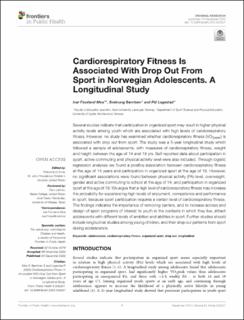| dc.contributor.author | Moa, Ivar Fossland | |
| dc.contributor.author | Berntsen, Sveinung | |
| dc.contributor.author | Lagestad, Pål Arild | |
| dc.date.accessioned | 2021-03-01T13:08:48Z | |
| dc.date.available | 2021-03-01T13:08:48Z | |
| dc.date.created | 2020-11-27T14:09:32Z | |
| dc.date.issued | 2020 | |
| dc.identifier.citation | Moa, I. F., Berntsen, S. & Lagestad, P. (2020). Cardiorespiratory fitness is associated with drop out from sport in Norwegian adolescents. A longitudinal study. Frontiers in Public Health, 8: 502307. doi: | en_US |
| dc.identifier.issn | 2296-2565 | |
| dc.identifier.uri | https://hdl.handle.net/11250/2730952 | |
| dc.description.abstract | Several studies indicate that participation in organized sport may result in higher physical activity levels among youth which are associated with high levels of cardiorespiratory fitness. However, no study has examined whether cardiorespiratory fitness (VO2peak) is associated with drop out from sport. The study was a 5-year longitudinal study which followed a sample of adolescents, with measures of cardiorespiratory fitness, weight and height between the age of 14 and 19 yrs. Self-reported data about participation in sport, active commuting and physical activity level were also included. Through logistic regression analyses we found a positive association between cardiorespiratory fitness at the age of 14 years and participation in organized sport at the age of 19. However, no significant associations were found between physical activity (PA) level, overweight, gender and active commuting to school at the age of 14, and participation in organized sport at the age of 19. We argue that a high level of cardiorespiratory fitness may increase the probability for experiencing high levels of enjoyment, competence and performance in sport, because sport participation requires a certain level of cardiorespiratory fitness. The findings indicates the importance of removing barriers, and to increase access and design of sport programs of interest to youth in the contexts in which they live, attract adolescents with different levels of ambition and abilities in sport. Further studies should include longitudinal studies among young children, and their drop out patterns from sport during adolescence. | en_US |
| dc.language.iso | eng | en_US |
| dc.publisher | Frontiers | en_US |
| dc.rights | Navngivelse 4.0 Internasjonal | * |
| dc.rights.uri | http://creativecommons.org/licenses/by/4.0/deed.no | * |
| dc.title | Cardiorespiratory fitness is associated with drop out from sport in Norwegian adolescents | en_US |
| dc.type | Peer reviewed | en_US |
| dc.type | Journal article | en_US |
| dc.description.version | publishedVersion | en_US |
| dc.rights.holder | © 2020 The Author(s) | en_US |
| dc.subject.nsi | VDP::Samfunnsvitenskap: 200::Samfunnsvitenskapelige idrettsfag: 330 | en_US |
| dc.source.pagenumber | 6 | en_US |
| dc.source.volume | 8 | en_US |
| dc.source.journal | Frontiers In Public Health | en_US |
| dc.identifier.doi | 10.3389/fpubh.2020.502307 | |
| dc.identifier.cristin | 1853433 | |
| dc.description.localcode | Unit Licence Agreement | en_US |
| dc.source.articlenumber | 502307 | en_US |

